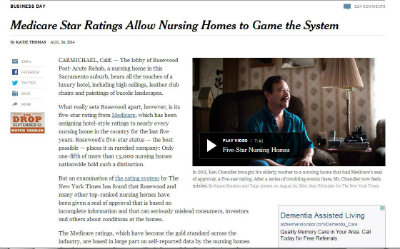 Yesterday, the New York Times had an interesting piece looking at the star rating system that Medicare has been using to evaluate long-term care facilities.
Yesterday, the New York Times had an interesting piece looking at the star rating system that Medicare has been using to evaluate long-term care facilities.
Coincidentally, I was moved to learn that a family friend, my “Aunt Betsy,” has been in an institution for going on 10 years, exceeding almost every expectation for longevity in advanced dementia.
The Times writer, Katie Thomas, observes that much of the data that drives this public reporting system, Nursing Home Compare, of “hotel-like,” 1- to 5-star ratings comes from institutional self-report and seems susceptible to gaming—including staffing up for the critical two weeks that are the basis of reporting for the year’s rating, and then letting the staff go immediately afterward. Sort of the way that television shows pump up their ratings with guest stars during sweeps week and then fall back to meh afterwards.
Notably, almost 50 percent of facilities are getting top, 4- or 5-star ratings, overall, in 2013. That’s up from 37 percent in 2009. However, there has been no change in the one externally assessed criterion: state health department inspections, on which a constant 34 percent of homes have attained top scores.
I just don’t know what to make of the Times’ investigation. They seem to be mixing issues that mostly impact short-stay, sub-acute care patients recovering after a hospitalization with those that mostly impact long-term residents, who are overwhelmingly older adults with frailty, multiple chronic conditions, and dementia.
Discovering that nursing homes are troubled hardly strikes me as “news.” Just a few months ago, we all learned that one of the reasons it has been so difficult to eliminate the dangerous, off-label use of antipsychotics turns out to be explained by U.S. Department of Justice-led investigations into kick-backs and bribes in the industry.
We, as a country have attempted to improve nursing homes in the United States many times. We have tried the teaching nursing home program, regulatory requirements such as OBRA ’87, the Minimum Data Set, culture change, the Advancing Excellence Campaign, Green House and other small house nursing home models, and now public reporting.
To the extent that the Times article makes a recommendation, it seems to suggest that external review of nursing home quality measures would be useful. And in a follow-up editorial published today, the Times observes that the Affordable Care Act mandated that staffing levels be verified by payroll data, although this effort appears to be delayed.
Nevertheless, it remains to be demonstrated that these changes will help. Certainly, by itself, a well-functioning rating system will not be enough.
As I see it, the problem with nursing home quality is too big to be solved simply by improving public reporting. The real issue is with the public’s attention to and understanding of the importance of fixing the problems in nursing homes. We all know that nursing homes are places we don’t want to go, just as most staff who work there know that they don’t want to be there, either.
The quality of care still is such that most Americans would tell you that they would rather die than go to a nursing home. But our national strategy for quality improvement in long-term care seems to be to collectively hope that we won’t have to go. Since 70 percent of Americans will spend at least some time in institutional long-term care, the ironic joke is that you get to go to a nursing home and you get to die. It isn’t multiple choice.
We need to realize that any of us could have an Aunt Betsey in a nursing home for 10 years or we could be Aunt Betsey. We may or may not need public reporting, but we certainly need a great deal more public attention to a place where most of us will spend some very critical and vulnerable time.
